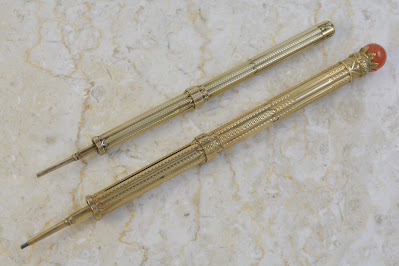This article has been edited and included in The Leadhead's Pencil Blog Volume 6, now on sale at The Legendary Lead Company. I have just a few hard copies left of the first printing, available here, and an ebook version in pdf format is available for download here.
If you don't want the book but you enjoy this article, please consider supporting the Blog project here.
(Originally scheduled to post May 10, 2018)
I wrote up everything I could find about the colorful Albert G. Bagley in a series of articles here a couple months ago (starting at "From Bagley through Todd"). Usually, when they turn up they are in the form of fluted-barrel combination dip pens and pencils, such as these:
The clutched ball on that lower example is a dead giveaway of a Bagley - the top example, with the plain, rounded end is a little bit unusual. Both of these have a top half that telescopes out slightly, to reveal the only markings you’ll typically find on these, other than on the nib if they still have the right one:
Patent January 1, 1850, a reference to patent number 6,981:
The specifications accompanying the drawing indicate that Bagley’s patent pertained to the way that upper section telescopes into position to make a longer writing instrument for writing.
I’m no pencils-only purist when it comes to Victorian writing instruments, as many of the earliest pieces in my collection are combination dip pens and pencils - and other weird things such as letter openers and such. But I was happy to find this one:
Bagley’s name is in the corner of the cartouche:
There’s no indication that this one is patented, but excitedly I checked American Writing Instrument Patents 1799-1910 to see whether Bagley patented a pencil only. He did:
You’ve really got to wade through the accompanying specification to get to Bagley’s point and see what was new and different about his Patent number 4,840, issued on November 6, 1846. His pencil mechanism (which fit into a longer barrel, to explain why this one is so short) had what was at the time a novel place to store spare leads: in grooves around the mechanism:
Unfortunately, mine lacks this feature. Instead, it has a fixed mechanism that doesn’t pull out, with a cap that screws off revealing a more conventional lead magazine. Oooh... maybe mine is earlier than 1846? No way to tell for sure.
I hoped the name engraved on the barrel, H. Seybert, might be distinct enough to help, but I found records of two people that could have been the pencils owner: Horace B. Seybert and Henry Seybert, both of Wilkes-Barre, Pennsylvania, and references to their activities span the entirety of Bagley’s career in New York, from 1839 (according to Bagley himself, although I haven’t been able to confirm anything earlier than 1842) through his retirement in 1856.
UPDATE: I’m glad I didn’t post this article, because in the time since I wrote it, I've learned a bit more. Eric Magnuson contacted me to let me know he had an 1846 Bagley Patent pencil, which wound up finding a home here:
The back half extends to make writing more comfortable:
“So where does this one say Bagley 1846?” I asked. I never would have found it . . .
It’s in about the worst place to put an imprint, where friction easily grinds them away over time.
“Bagley’s Patent 1846,” the faint lettering reads – good thing Eric’s eyes are better than mine. A tiny slot in the cap allows leads to be inserted. Still, no lead storage around the central chamber as shown on the patent drawings, though:
So . . . I wondered . . . maybe that generic pen/pencil combo I’ve had in my parts bins for all these years isn’t so generic after all . . .
Now that I know where to look, I won’t be stealing any parts from this one!















No comments:
Post a Comment